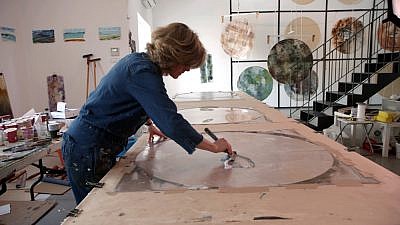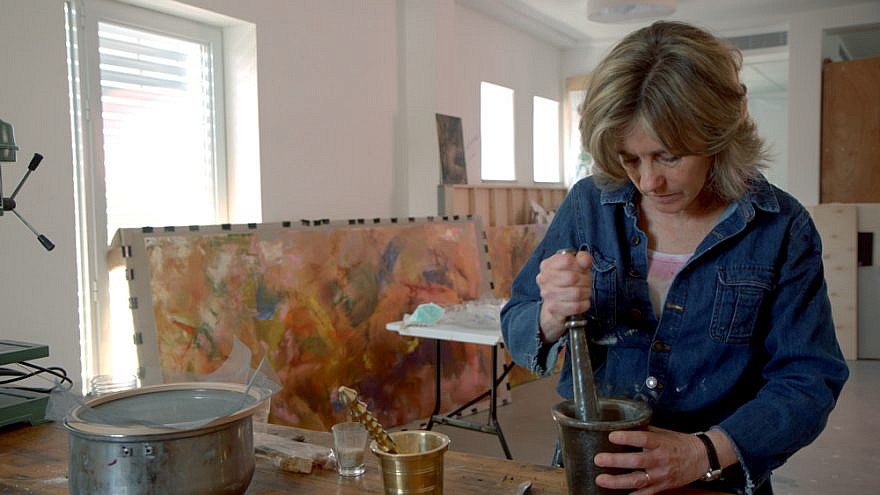In her Jerusalem studio, in the top two floors of an unassuming building, Israeli artist Beverly Barkat is putting the final touches to her latest and most ambitious exhibition to date. She is paying homage to, and finding inspiration in, the biblical 12 tribes when they were most intimately connected to Land of Israel in her latest installation, aptly titled “After the Tribes.”
It follows on the heels of her successful “Evocative Surfaces” exhibition at the Venice Art Biennale 2017.
But Barkat felt that it was not enough to just celebrate Israel’s 70th year; she felt driven to delve backwards into Israel’s 3,000-year history.
“I wanted to examine the elements of the Jewish nation, and why the Jews are who they are: creative, out-of-the-box thinkers. What is this heritage?” asked Barkat. “What is the connection we have to Israel? What makes the emotions so strong? Seventy years show the world the modern connection to the state, but there is much more than that. Our connection is more than 3,000 years old.”

“After the Tribes” is a bold, four-meter towering structure created from a wrought-iron metal framework—an artistic representation of the biblical priestly breastplate known as the hoshen, which was made up of 12 gemstones representing each one of the tribes. Twelve circular paintings on translucent PVC—each one meter in diameter—appear to float within 12 square frames representing the 12 tribes of Israel within the metal structure of the installation, each with its own specific color palette specified in the ancient texts.
“The title has two layers of meaning,” says Barkat. “I started this project by spending a lot of time studying and researching the stories of the tribes—going “after” them, looking for any traces and energy they left behind. Then I started to connect these stories to the issues of the Jewish people today—to retrace our origins, our genetic code, to gain a more textured understanding of our past in order to allow us to have a richer future. I am opening a discussion into how the modern Jewish people all over the world relate to the legacy of the ‘Twelve Tribes of Israel’ thousands of years later and how we might look at ourselves today.”
Barkat examined medieval and renaissance-era maps that defined the geographical territories of tribes in biblical times. She then created her color palettes by incorporating actual physical elements from each tribal region, collecting soil, stones and shells from the place where the tribe dwelt and their assigned gem. Her one partner on the journeys across the country to unearth and to gather the raw materials was her husband, the current mayor of Jerusalem.

“These road trips gave me the understanding and legitimacy as to why I am here, why I am raising my children here and why I have stayed here. It is an incredibly deep bond,” says Barkat, a South African native who came to Israel as a child with her artist parents. In 1976, they were invited to teach ceramics at the Bezalel Academy of Arts and Design in Jerusalem. What was supposed to be a year-and-a-half stint turned into a life-changing event, with the entire family deciding to remain in Israel.
Barkat drew on a wealth of artistic knowledge and training—metal work, architecture, design and painting—to develop a piece that encompasses her identity as an Israeli and a Jew. By hand, she ground the material into tiny fragments in a pestle and mortar, similarly pastel pigment was mixed with the acrylic medium, much like the old masters did when they created their own oil paints mixed with oxides.
For example, the ochres, sand colors and reds of the soil are mixed with fragments of amethyst for the tribe of Gad, agate for the tribe of Naphtali and emerald for the tribe of Levi. Her palette is also inspired by the character of each tribe, their livelihood and profession. Some, like Asher, worked in agriculture caring for olive trees; others, like Zebulun, worked in commerce and were seafarers; and still others were educators, such as Simon (Shimon).
The 12 circular paintings can be viewed from both sides. The artist applied her materials to one side, leaving the other rough and textured, while the other side offers a view through the transparent PVC support, revealing the layers of color, the painter’s marks and their real consistency under a smooth, glossy film. Hung by thin taught metal cords, the installation can be walked around, giving the viewer a dialogue with both sides of the artwork.

“Every single part of me is in this,” attests Barkat. “It is an artwork that I hope pulls the viewer into my world. I immersed myself in the depth and complexity of the relationships among the tribes, both past and present, and the relationship between those tribes and the land. It is an artwork which needs to engage people, and make them challenged and to ask questions of some kind. If people start to ask questions, I have done my job.”
“After the Tribes,” curated by Giorgia Calò, will open on Oct. 10 in Rome and travel to other countries before returning to Israel.

























